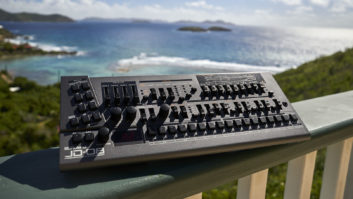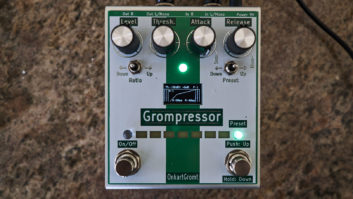
The Morton KickTone microphone is designed to capture high-SPL, low-frequency sounds. As its name implies, the KickTone mic is for the drum kit’s bass drum, but it works great in picking up the sound of any drum, bass instrument, keyboard or even vocal.
The KickTone starts with a dynamic element with a 5.25-inch polycarbonate diaphragm encased in a tough, ABS plastic case that measures 6.5 inches in diameter and 3.5 inches deep. The mic weighs about 2 pounds and is slightly conically shaped, with a strong stainless steel mesh in front of the dynamic element inside to protect it. It also has nine mesh-covered, oval vents surrounding the side.
The KickTone actually contains two microphone elements, with a high-frequency mic (in the 4 to 7 kHz range) mounted just over the center of the main element. The two elements’ outputs are summed together using a passive resistor network to the output. KickTone has a rated output impedance of 100 ohms.
The KickTone mic has a male Neutrik XLR output connector mounted next to a standard threaded microphone mount. This mount swivels and locks down for exact positioning in front of a kick drum. The microphone is rated from 10 Hz to 10 kHz, with a sensitivity of 87 dB SPL measured at 1 meter. Maximum SPL is 175 dB.
NUGEN Audio Paragon ST – A Real-World Review
The KickTone has a slide bracket, or flange, on its front that matches a KickPort, a popular bass drum enhancer that is installed in a 5.25-inch hole in the kick drum’s front resonant head. This makes KickTone usable in two ways: on a short mic stand in front of the kick drum or attached directly to the KickPort itself without a stand. No stand offers a cleaner stage look, and, as the mic is mounted directly on the front head, there is less leakage picked up from the rest of the kit, as well as from the stage.
We tested the Morton KickTone microphone in a few different positions in the studio on the same Ludwig 14 x 22 bass drum. First up was to replace our usual microphone in a similar position out in front of the resonant front head.
We got good subsonic energy, but felt we needed a more high-frequency attack to cut through the song we were recording—a second mic in phase with the KickTone would take care of that! We then tried it exactly over the hole in the head and got a little more attack with the same sub energy.
Audio-Technica AT2040 Hypercardioid Dynamic Mic – A Real-World Review
I was dying to try the KickPort, so the third test was with KickTone attached to it. This is an instant winner; just slide the KickTone on, and with the bass drum sealed up and somewhat deader, we obtained much more subsonic energy and more high-frequency attack as well. In addition, my drummer noticed a different (playing) feel with a noticeable difference in the way the beater hit the head.
There was also much less leakage from the rest of the kit. Any live sound mixer will love the minimal leakage and also love the option to drive the subwoofers to whatever the music demands. This was our favorite sound and use of KickTone.
But we also tried removing the front head and moved the mic to near the center of the drum and about halfway inside. The mic picked up a lot less sub, with a midrange “honk” in the 700Hz range. This sound would require using an equalizer to pull the sound more into a usable state.
One note: The location of the XLR jack on the mic causes the XLR mic cable connector to be in the way of the swivel mount. This limits the angles possible for the mic on the end of a short boom stand.
I enjoyed using the KickTone microphone, and my drummer/engineer/producer, who was skeptical about it, is now a true believer. So am I! Highly recommended, especially for live sound work for a fast, no-brainer and consistent sound pickup of kick drums. Slide the KickTone on the KickPort and you’re good to go!







